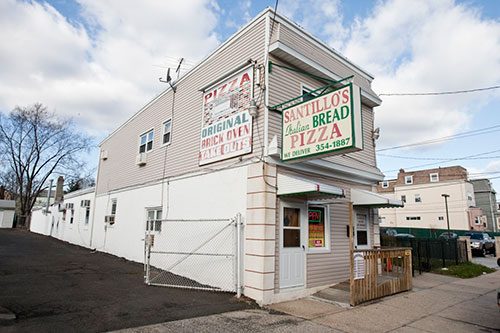
At Santillo’s Brick Oven Pizza in Elizabeth, Al Santillo eyes me skeptically as I inquire about his craft. “I can’t teach you in five minutes,” he says. “I spent my whole life learning this. If you want to learn, you have to spend time here.”
Outside it’s snowing, and I feel lucky to have found the place. The narrow residence on South Broad Street seemed far too nondescript, even disguised, to be a pizzeria, despite the weathered electric sign overhead. The front doors are locked permanently, and don’t lead to the pizzeria anyway. I followed the sign down an alley to the modest side door, marked “ENTRANCE,” and stepped inside. Clearly I’d arrived someplace special.
With no tables, a tiny counter, and barely anyplace to stand, Santillo’s feels like a typical family kitchen. But off to the right, in a wall of brick, is the blackened steel door of the biggest oven I’ve ever seen, 14 feet wide by 20 feet deep.
Santillo lets me peer inside. The oven’s brick ceiling is arched like a subway tunnel, but low, only a couple feet above the oven floor, which is covered in big square bricks. “See those bricks?” he says. “Those have been seasoned a hundred years. They retain a bit of the flavor and taste and give some back to each pie.” Santillo—who runs the place with his wife, Lorraine, and at various times has had his three children working at his side—plays the oven like a Wurlitzer.
“I know which spot is 600, which is 650 or 700 degrees,” he says, explaining he likes the oven floor to be a little hotter than the air above it so that the crust bakes crisp but the sauce and cheese don’t burn. (“I like to bake from the bottom up.”) I begin to wonder if the oven should be designated a national historic landmark. It was built in 1905—a coal-burning workhorse for a German bakery. In the early 1990s, Santillo had it retrofitted with gas.
Santillo’s deep relationship with this immense cavern began in 1957, when his father (also named Al) bought this house and nurtured both family and business here. Young Al began apprenticing at age 5. Today, he’s 52, but in pizza years, he’s a much older soul. Like many a serious New Jersey pizza man, his cooking is a conversation with ancestors. His grandfather had a bread bakery in Elizabeth in 1918. Santillo also bakes his own Italian bread. After doing the same job day in and day out for decades, he knows this: “It’s not just the business. It’s the life you get with it.”
That life is one of almost monkish devotion to tending the idiosyncratic oven and chatting with his regular customers. He will cook pies to order, but makes no secret of his belief that pies are meant to be cooked dark, “to achieve the Santillo taste.” That means the crust should be crispy and firm. He uses a particular secret blend of low-moisture shredded mozzarella and thick sauce that exudes vibrant tomato taste. As distinctive as his oven is Santillo’s menu, which lists pies according to his idea of a given year’s signature style: a 1940 tomato pie (no cheese), a 1957 (extra thin), a 1964 (a little olive oil and Parmesan).
With no place to sit, this is strictly takeout. But Santillo has a deal with the Vasco da Gama tavern around the corner, where his customers can take their pies to eat. My young sons and I take our plain pie to the car. As we bite into the perfect, crunchy crust and taste the sweet tang of tomato and cheese, we are overcome. Might this be the best pizza in the state?
My assignment was to search for the soul of New Jersey pizza. What is its essential nature? With thousands of pizza joints in the state, it’s an impossible task. And yet, after much eating, driving, tasting, and talking to makers and experts, I came up with a few theories:
1. Pizza is highly subjective.
Proust had his madeleine; we have our crispy tomato and cheese pie. Whatever your earliest or happiest pizza experience, chances are it has imprinted itself as the icon of what pizza (and perhaps life) should be. Slices with friends in high school. The place your dad took you. The weekly childhood treat that offered respite from the regularity of mom’s home cooking. Not surprisingly, long-lived pizzerias are usually family-operated places that pride themselves on never changing their recipe one iota.
Take Pizza-Town U.S.A. in Elmwood Park, where the décor is pure 1958—the year Raymond Tomo opened this roadside stand covered with American stars and stripes, where a huge illuminated Uncle Sam hovers above the roof holding out a whole pie. Cars and trucks whiz by on Route 46. Inside, the ambience is pure bus station—one window for slices, the other for whole pies.
“People love the nostalgia,” says Bruce Tomo, Raymond’s son, who now runs the place with his sister Michele and gets help from their sister Lisa. Their commitment is so strong that each and every day one of them is there with hands in dough. When I suggest some people might find their exterior décor a bit much, Tomo says, “We have no intention of changing. So many places are corporate and sterile. We want to keep the vision our father began with.”
That vision extends to the pizza. “Ours is more of an old fashioned pie,” Tomo says. “It’s thin and crunchy. We use a good amount of homemade tomato sauce and go light on the cheese. Lots of pizza today is undercooked with doughy crusts, too much cheese, and not much flavor.”
Three minutes after my pie goes in the oven, it’s ready, its light patches of cheese bubbling amid splotches of tomato sauce on crunchy crust. It is light and delicious. I can taste all the flavors, which seem perfectly in balance.
Eighty percent of business, Tomo estimates, comes from return customers. Some, relieved the pizza tastes the same as ever, carry pies back to the distant (and pizza-deprived) states where they live now.
2. Our pizza roots run deep.
“In the history of American pizza, you’ve got three main locations: New York, New Haven, and New Jersey,” says Ed Levine, author of Pizza: A Slice of Heaven and publisher of the website slice.seriouseats.com. “People have been making pizza in New Jersey since before 1920, which is pretty amazing, if you think about it.”
The historical record has pizza turning up around the same time on both sides of the Hudson: 1905 at Lombardi’s in New York City and 1910 at Joe’s in Trenton (see story, page 50). The real roots stretch back to the Neolithic period, about 8,000 years ago, when the first flatbreads were baked on hot stones. Later, ancient Romans, Greeks, and Persians topped their breads with things like olive oil, garlic, and cheese. It wasn’t until Columbus brought the tomato back from the New World to meet its destiny in Italy that modern pizza came into being. In nineteenth-century Naples the dish achieved glory, and, shortly after, began its journey to the U.S. in waves of emigration by Southern Italians.
The immigrants used fresh mozzarella and fresh plum tomatoes, and cooked their pizza in coal-burning brick ovens (in Italy the fuel was wood). You can try this old-style coal-oven pizza at Grimaldi’s in Hoboken and Brooklyn’s in Hackensack, Edgewater, and Ridgewood. These establishments are descended from associations with the famous Patsy’s in Harlem, which began in the 1930s. The mozzarella is fresh, moist, and thin-sliced (as opposed to the aged, low-moisture, shredded variety that is the modern norm).
In fact there seems to be a nostalgic revival of the coal-burning brick oven. In Red Bank, a place called Tommy’s Coal-Fired Pizza has opened, and another called Pazzo was in planning stages at press time.
Proponents say coal produces a higher, steadier heat than wood and more quickly crisps the dough.
“Our ovens reach 900 degrees,” says Sean McHugh, a former oven builder and co-founder, with Patsy Grimaldi, of Grimaldi’s in Hoboken. “We can cook a pie in 90 seconds.” When he found out I was doing this article, he wouldn’t let me leave the dining room with my pizza in a box.
“You have to taste it right out of the oven,” he said. I could tell he was serious, so I sat down at a table with my coat on. I tasted. He was right. It was glorious pizza, with a slightly charred crust and a rich sweet taste on account of the fresh mozzarella.
3. New Jersey pizza came into its own after 1945.
GIs returning from duty in Italy after World War II helped take pizza from ethnic to mainstream. The emergence of the new gas-fired, steel pizza oven also played a role. The ovens are mass produced and easier to regulate and clean than the old coal ovens. Gas ovens are usually run at about 500 to 600 degrees, yet can turn out pizza quickly enough to meet demand.
While there are exceptions, ready-made ingredients such as canned tomatoes and low-moisture American mozzarella became the rule. The pale yellowish cheese lasts longer on the shelf and melts more evenly. Pizzas became larger, reaching 16 or even 22 inches in diameter. With car culture, pizza became road food and pizza by the slice the universal grab-and-go.
4. Techniques vary.
At the 75-year-old Spirito’s in Elizabeth, co-owner Frank Spirito tells me they buy cheese in blocks and cube it, rather than use pre-shredded. The result is pizza with “puddles” of cheese that stay separate from the sauce. “We never refrigerate the dough,” he says. “We make it every morning, and if we don’t use it that night, we throw it away and start fresh the next day.” Some pizzerias let their dough rise for longer periods to achieve better flavor.
Another technique can be seen at Freddie’s in Long Branch, founded in 1944, where the tomato sauce is ladled onto the dough raw, “so it doesn’t cook twice, and retains more fresh flavor,” says co-owner Richie Iadanza.
Ultimately, New Jersey pizza is as varied as the people who make it. In his little kitchen in Elizabeth, Al Santillo makes a large, square Sicilian pizza that he calls the Grandpa. The crust is a little thinner than most Jersey Sicilian pie, but is still thicker than standard pizza. He tops it with thick, criss-crossing lines of all his various toppings—sausage, meatballs, hot peppers, onions, pepperoni, anchovies—the works. He aims for the opposite of uniformity. “My father liked a different flavor in every bite, so that’s how I make it,” he says.
Why call it Grandpa, then? “My father had eight kids,” Santillo explains, “so he had so many grandkids he was always being called ‘Grandpa.’ Once he got to 80, even I started calling him ‘Grandpa.’”
Contributing writer Laura Schenone’s most recent book, now in paperback, is The Lost Ravioli Recipes of Hoboken.
Click on the links below to read more pizza stories from our dining issue:




best pizza bayonne was patsy’s d’angelo’s